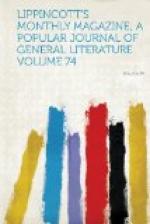Care for the visitor’s comfortable locomotion does not end with depositing him under the reception-verandah. The Commission did not forget that a pedestrian excursion over fifteen or twenty miles of aisles might sufficiently fatigue him without the additional trudge from hall to hall over a surface of four hundred acres under a sun which the century has certainly not deprived of any mentionable portion of its heat. Hence, the belt railway, three and a half miles long, with trains running by incessant schedule—a boon only to be justly appreciated by those who attended the European expositions or any one of them. His umbrella and goloshes pocketed in the form of a D.P.C. check, the visitor, more fortunate than Brummel or Bonaparte, cannot be stopped by the elements.
[Illustration: Facade of the Swedish division, main building.]
We shall have amply disposed of the subject of transportation when we add that the neighborhood or city supply to the thirteen entrance-gates is provided for by steam-roads capable of carrying twenty-four thousand persons hourly, and tram-roads seating seven thousand, besides an irregular militia or voltigeur force of light wagons, small steamers and omnibuses equal to a demand of two or three thousand more in the same time. It was not deemed likely that Philadelphia would require conveyance for half of her population every day. Should that supposition prove erroneous, the excess can fall back upon the safe and inexpensive vehicle of 1776, 1851, 1867 and 1873—sole leather.
Let us return to our packing-cases, and see where they go. To watch the gradual dispersal of a congregation to their several places of abode is always interesting. Especially is it so when those places of retreat bear the names and fly the flags of the several nations of the globe. This stout cube of deal, triple-bound with iron, disappears under the asp and winged sphere of the Pharaohs. That other, big with rich velvets and broideries, seeks the tricolor of France. Yonder, a wealth of silks and lacquer finds a resting-place in the carved black-walnut etageres of Japan. Here go, cased in the spoils of the fjelds, toward a pavilion seventy-five paces long and twenty wide, the bulky contributions of the Norsemen. Swedish carpentry in perfection offers to a deposit separate from that of the sister-kingdom a distinct




